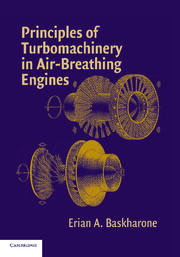Book contents
- Frontmatter
- Contents
- Preface
- 1 Introduction to Gas-Turbine Engines
- 2 Overview of Turbomachinery Nomenclature
- 3 Aerothermodynamics of Turbomachines and Design-Related Topics
- 4 Energy Transfer between a Fluid and a Rotor
- 5 Dimensional Analysis, Maps, and Specific Speed
- 6 Radial-Equilibrium Theory
- 7 Polytropic (Small-Stage) Efficiency
- 8 Axial-Flow Turbines
- 9 Axial-Flow Compressors
- 10 Radial-Inflow Turbines
- 11 Centrifugal Compressors
- 12 Turbine-Compressor Matching
- References
- Index
3 - Aerothermodynamics of Turbomachines and Design-Related Topics
Published online by Cambridge University Press: 05 September 2012
- Frontmatter
- Contents
- Preface
- 1 Introduction to Gas-Turbine Engines
- 2 Overview of Turbomachinery Nomenclature
- 3 Aerothermodynamics of Turbomachines and Design-Related Topics
- 4 Energy Transfer between a Fluid and a Rotor
- 5 Dimensional Analysis, Maps, and Specific Speed
- 6 Radial-Equilibrium Theory
- 7 Polytropic (Small-Stage) Efficiency
- 8 Axial-Flow Turbines
- 9 Axial-Flow Compressors
- 10 Radial-Inflow Turbines
- 11 Centrifugal Compressors
- 12 Turbine-Compressor Matching
- References
- Index
Summary
In this chapter, the flow-governing equations (so-called conservation laws) are reviewed, with applications that are purposely turbomachinery-related. Particular emphasis is placed on the total (or stagnation) flow properties. A turbomachinery-adapted Mach number definition is also introduced as a compressibility measure of the flow field. A considerable part of the chapter is devoted to the so-called total relative properties, which, together with the relative velocity, define a legitimate thermophysical state. Different means of gauging the performance of a turbomachine, and the wisdom behind each of them, are discussed. Also explored is the entropy-production principle as a way of assessing the performance of turbomachinery components. The point is stressed that entropy production may indeed be desirable, for it is the only meaningful performance measure that is accumulative (or addable) by its mere definition.
The flow behavior and loss mechanisms in two unbladed components of gas turbines are also presented. The first is the stator/rotor and interstage gaps in multistage axial-flow turbomachines. The second component is necessarily part of a turboshaft engine. This is the exhaust diffuser downstream from the turbine section. The objective of this component is to convert some of the turbine-exit kinetic energy into a static pressure rise. Note that it is by no means unusual for the turbine-exit static pressure to be less than the ambient magnitude, which is where the exhaust-diffuser role presents itself.
In terms of the flow-governing equations, two nonvectorial equations will be covered in this chapter. These are the energy- and mass-conservation equations (better known as the First Law of Thermodynamics and the continuity equation, respectively).
- Type
- Chapter
- Information
- Principles of Turbomachinery in Air-Breathing Engines , pp. 26 - 111Publisher: Cambridge University PressPrint publication year: 2006



